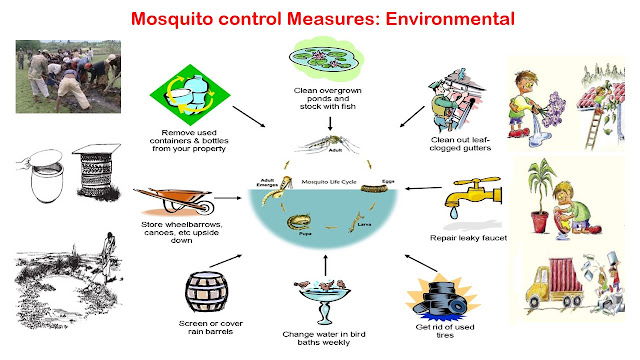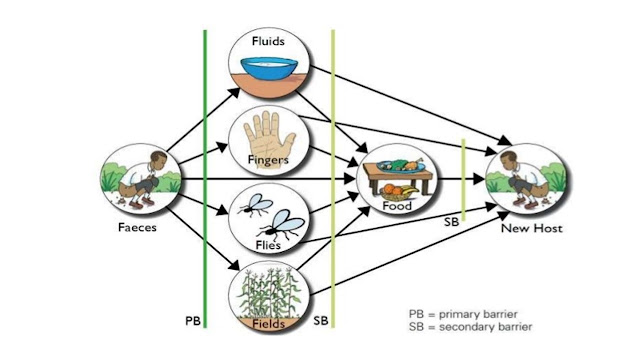Spotters in "Environment and Health: Water" for CFM & MPH students
1. Sanitary well:
 |
Important points:
- Location: Not less than 15 m (50 feet) from likely sources of contamination & at a higher elevation. Not more than 100 m from houses
- Lining: Should be made up of bricks/ stones & cement up to a depth of at least 6 m (20 feet) and 60-90 cm (2-3 feet) above the ground
- Parapet wall: up to a height of 70-75 cm (28 inches) above the ground
- Platform: Extending at least 1m (3 feet) in all directions with a gentle slope towards the drain.
- Drain: pucca drain around the well to carry off spilled water to a public drain or soakage pit.
- Covering: Top closed by a cement cover.
- Hand pump: If possible it should be equipped with a hand pump in a Sanitary manner.
2. Slow sand filter:
Important points:
- Space: Occupies a large area
- Rate of filtration: 2-3 m.g.a.d
- The effective size of sand: 0.2-0.3 mm
- Preliminary treatment: Plane sedimentation.
- Washing: By scraping the sand bed
- Operation: Less skilled
- Loss of head allowed: 4 feet (1.5 m)
- Removal of turbidity: Good
- Removal of color: Fair
- Removal of bacteria: 99.9-99.99 %
3. Rapid sand filter:
Important points:
- Space: Occupies very little space
- Rate of filtration: 200 m.g.a.d
- The effective size of sand: 0.4-0.7 mm
- Preliminary treatment: Chemical coagulation & sedimentation.
- Washing: By backwashing
- Operation: Highly skilled
- Loss of head allowed: 6-8 feet (2-2.5 m)
- Removal of turbidity: Good
- Removal of color: Good
- Removal of bacteria: 98-99 %
4. Berkefeld filter:
Important points:
- Used for water purification on a small scale
- Essential part of the filter is candle which is made up of infusorial earth (porcelain in Chamberland/ kieselguhr)
- Usually removes bacteria but not the viruses
- Should be cleaned by scrubbing with a hard brush under running water & boiled at least once a week
- Only clean water should be used
5. Bleaching powder/ Chlorinated lime (CaOcl2):
Important points:
- White amorphous powder with a pungent smell
- When freshly made it contains about 33% of available chlorine.
- On exposure to air, light & moisture it rapidly loses its chlorine content.
- But when mixed with an excess of lime, it retains strength & is known as stabilized bleach.
- Should be stored in a dark, cool, dry place in a closed container that is resistant to corrosion.
6. Chlorine tablets/ Halazone tablets:
Important points:
- Good for disinfecting small quantities of water
- Costly
- NEERI, Nagpur has formulated a new type which is 15 times better than the ordinary one
- A single tablet of 0.5 gm is sufficient to disinfect 20 litres of water
7. Potassium permanganate:
Important points:
- Once widely used, no longer recommended for water disinfection
- A powerful oxidizing agent
- It may kill cholera vibrio's, but little use against other organisms.
- It alters the color, smell & taste of water
8. Horrock's apparatus:
Important points:
- It is designed to find out the dose of bleaching powder required for disinfection of water
- Contains 6 white cups, 1 black cup with a circular mark inside, 2 metal spoons, 7 glass stirring rods, one special pipette, 2 droppers, a starch-iodine solution, instruction folder.
- Procedure:
- One level spoonful (2g) of bleaching powder is placed in the black cup and made into a thin paste with a little water
- More water is added to the paste to bring up the volume to the circular mark. The solution thus prepared is the ‘Chlorine Stock Solution’
- The six white cups are filled with the water to be tested
- Using the pipette provided with the apparatus, add one drop of the stock solution to the first cup, two drops to the second cup, three drops to the third cup, and so on till adding six drops to the sixth cup.
- Stir the water in the cups; use a separate rod for each cup
- Wait for half an hour
- Add three drops of starch-iodide indicator to each of the white cups
- The development of a blue color indicates the presence of free residual chlorine.
- The first cup which develops this color gives an estimate of the amount of bleaching powder needed to disinfect 455 L of the sample water.
- If the first cup develops blue color: 1 spoonful (i.e. 2gm) of bleaching powder would suffice for 455 L of water
- If the second cup develops blue color: 2 spoonfuls (4 gm) of bleaching powder for 455 L of water
9. The double pot method:
Important points:
- Used for disinfection with a constant dosage of chlorine to well water especially during an emergency.
- Devised by NEERI, Nagpur, India.
- The inside height & diameter are 30 cm & 25 cm respectively for the outer pot.
- A hole of 1 cm diameter is made in each pot.
- For the inner pot, the hole is in the upper part & for the outer pot, it is 4 cm above the bottom.
- A mixture of 1 kg of bleaching powder & 2 kg of coarse sand is prepared & slightly moistened with water.
- The inner pot is filled with this mixture up to 3 cm below the level of the hole.
- The inner pot is introduced into the outer one, & the mouth of later closed with polyethylene foil.
- The double pot is lowered into the well by means of a rope attached to the well kerb.
- The pot should be immersed at least 1m below the water level to prevent damage by the buckets used for drawing water.
- Works satisfactorily for 2-3 weeks in a small household well-containing water of about 4500 liters.
11. Orthotolidine test:
Important points:- Enables total, free, and combined chlorine in the water to be determined with speed and accuracy
- The reagent is ‘analytical grade Orthotolidine’, dissolved in 10% solution of HCl
- When this reagent is added to the water containing chlorine, it turns yellow
- The intensity of the yellow color is proportional to the concentration of chlorine
- This yellow color is produced by both free and combined chlorine
- However, OT reacts with free chlorine instantaneously but reacts more slowly with combined chlorine
- Add 0.1 ml of a reagent to 1 ml of water
- The yellow color is produced and matched against charts within 10 sec, this gives the amount of ‘free chlorine ’
- The yellow color appearing after a few minutes gives the amount of ‘Total chlorine ’
- The orthotolidine test, however, is not accurate, because the impurities such as iron, manganese, nitrate etc., are likely to cause a false yellow color, and indicating wrong and increased chlorine residual.
12. Step Well:
- Stepwells are wells or ponds in which the water is reached by descending a set of steps to the water level.
- Most of the step wells can be found in the hot, dry states of northern India -- particularly in Gujarat, Rajasthan, and Haryana.
- Known as vavs in Gujarat and baolis (or baoris) elsewhere in northern India
- Even today, there are around 2000 surviving stepwells in India.
- There are many, which retain water, although they are no longer in use, but have become treasured pieces of architecture from various eras.
References:
- Park, K. (2019). Park's textbook of preventive and social medicine. 25th. Jabalpur, India: M/S Banarsidas Bhanot.
- Kadri AM. (2019). IAPSM's Textbook of Community Medicine. 1st. New Delhi, India: Jaypee Brothers Medical Publishers (P) Ltd.
- https://www.exportersindia.com/alleduneedsa/sanitary-well-model-4171318.htm photo credit
- https://www.civilconcept.com/different-between-slow-sand-filterssf-and-rapid-sand-filterrsf/ photo credit
- https://www.indiamart.com/proddetail/slow-sand-filter-model-4096124662.html photo credit
- https://commons.wikimedia.org/wiki/File:Rapid_sand_filter_EPA.jpg photo credit
- https://www.incoindia.in/product/rapid-sand-filter photo credit
- https://pleasanthillgrain.com/british-berkefeld-filter-w-4-elements-ceramic photo credit
- https://en.wikipedia.org/wiki/Berkefeld_filter photo credit
- https://www.amazon.in/ATC-Premium-Bleaching-Powder-400g/dp/B072SV2K3H photo credit
- http://zilokart.com/shop/bison-bleaching-powder/ photo credit
- https://www.tradeindia.com/kolkata/chlorine-tablets-city-200579.html photo credit
- https://www.indiamart.com/proddetail/chlorine-tablets-20570631248.html photo credit
- https://poultryshorts.com/Poultry-product/disinfectants/potassium-permanganate-kmno4/ photo credit
- https://www.indiamart.com/proddetail/potassium-permanganate-21090816073.html photo credit
- https://www.youtube.com/watchv=dRq1682nZXE&list=PLKKWBex6QaMB1R8IHpYoR36rSn5SvMslC&index=10&t=0s&app=desktop photo credit
- https://www.indiamart.com/proddetail/horrocks-water-testing-kit-11661621988.html photo credit
- http://www.nzdl.org/gsdlmod? photo credit
- https://www.aliexpress.com/i/32876575122.html photo credit
- http://www.ihatepsm.com/blog/orthotolidine-ot-test-and-orthotolidine-%E2%80%93-arsenite-ota-test photo credit
- https://bijoor.me/2016/06/25/badlapur-step-well-a-rare-historical-site/ photo credit
- https://www.ancient-origins.net/news-history-archaeology/5000-year-old-stepwell-found-dholavira-said-be-largest-india-002291 photo credit
- https://www.freepressjournal.in/latest-news/10-most-gorgeous-step-wells-in-india photo credit
















👏👏👏👏
ReplyDelete